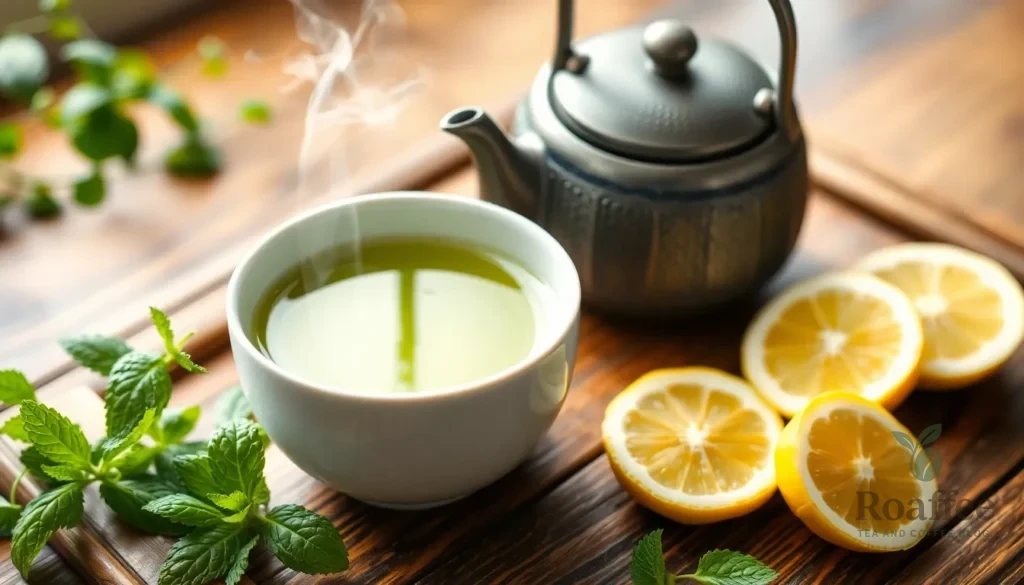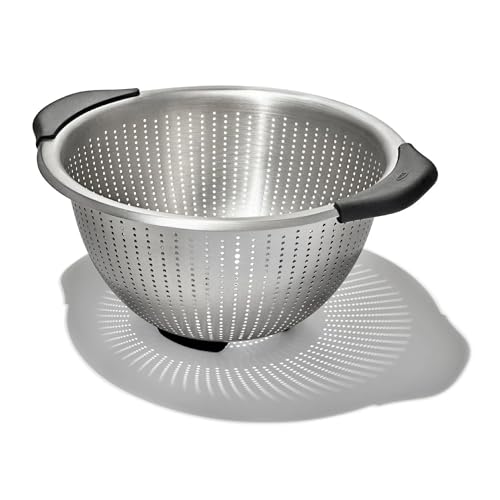Green tea’s reputation as a health powerhouse often overshadows one crucial detail – it doesn’t always taste great straight from the cup. We’ve all been there: brewing what should be a refreshing cup only to face a bitter, astringent liquid that makes us question why we’re putting ourselves through this wellness ritual.
The truth is that green tea’s naturally earthy and sometimes grassy flavor profile can be an acquired taste. Many people give up on this antioxidant-rich beverage before discovering its full potential. But here’s the good news: with the right techniques and flavor combinations we can transform your green tea experience from medicinal obligation to genuine enjoyment.
Whether you’re a complete beginner or someone who’s been struggling with bitter brews we’re about to share the secrets that’ll make your green tea taste absolutely delicious. These simple tricks will help you unlock flavors you never knew existed in your favorite healthy drink.
Why Green Tea Can Taste Bitter
Green tea’s bitter reputation stems from several key factors that we can easily understand and control. The primary culprit behind that harsh astringent flavor lies in compounds called tannins and catechins naturally present in tea leaves.
Oversteeping creates the most common bitter taste problem. When we leave tea bags or loose leaves in hot water too long the tannins extract excessively. These compounds serve as the tea plant’s natural defense mechanism against insects but they create an unpleasant puckering sensation in our mouths.
Water temperature plays a crucial role in flavor extraction. Many people pour boiling water directly over green tea leaves which scorches the delicate compounds. This aggressive heat treatment releases bitter elements while destroying the subtle sweet and grassy notes that make green tea enjoyable.
Tea quality significantly impacts the final taste profile. Lower grade green teas often contain more stems and broken leaves which contribute to harsh flavors. Mass produced tea bags frequently use tea dust and fannings that brew quickly but lack the balanced flavor of whole leaf varieties.
Storage conditions affect tea’s taste over time. Green tea exposed to light heat or air develops stale bitter notes as its natural oils oxidize. Old tea loses its fresh character and develops an unpleasant metallic taste that no amount of sweetening can mask.
Individual sensitivity to bitter compounds varies among people. Some taste buds detect tannins more intensely than others making certain individuals more susceptible to green tea’s harsh notes. This genetic variation explains why some people immediately enjoy green tea while others find it completely unpalatable.
Understanding these factors gives us the power to transform our green tea experience from bitter disappointment to flavorful satisfaction.
Choosing the Right Green Tea
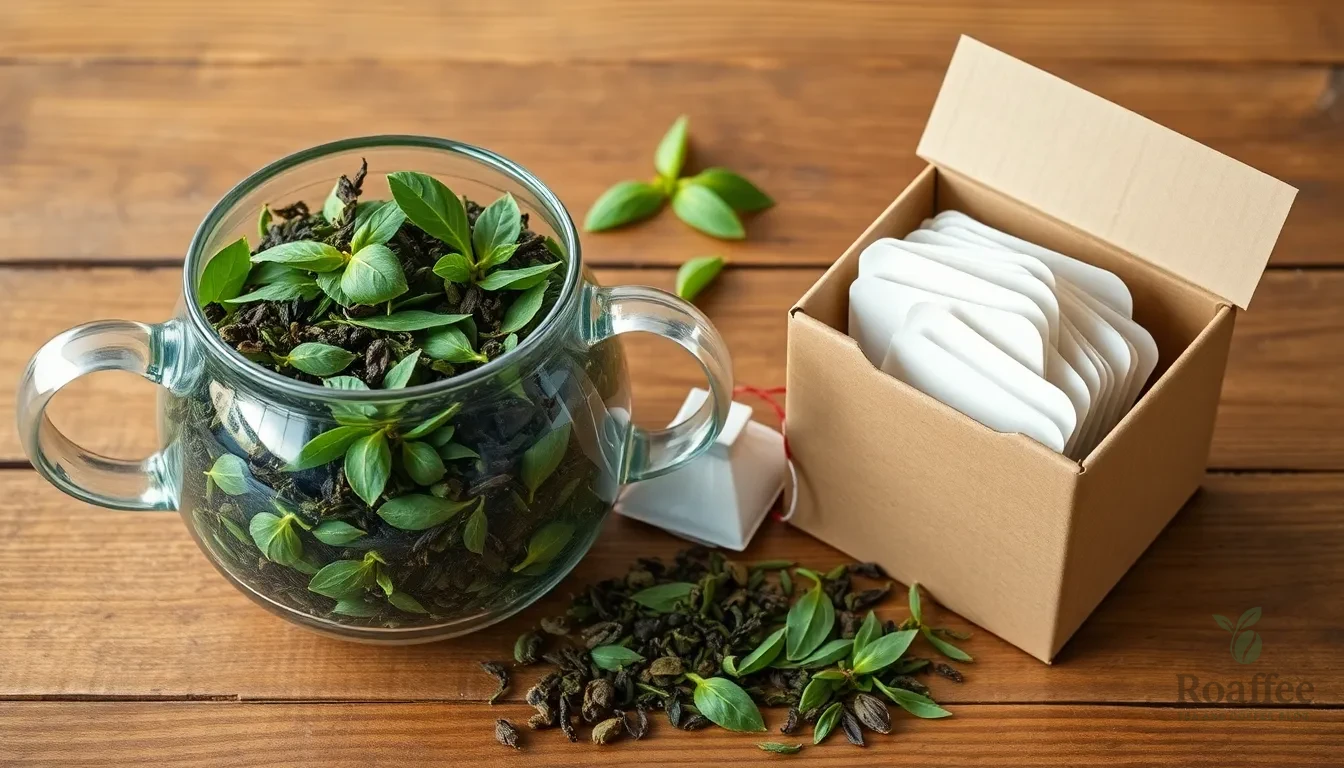
Now that we understand why green tea can taste bitter, let’s explore how selecting the right type of tea can dramatically improve your brewing experience. The quality and variety of green tea you choose forms the foundation of a delicious cup.
Loose Leaf vs Tea Bags
We strongly recommend choosing high-quality loose leaf green tea over tea bags for the best flavor experience. Loose leaf teas use whole leaves that produce a more complex and nuanced flavor profile. Tea bags often contain tea dust and fannings, which are small broken pieces of lower quality leaves that tend to impart a bitter or inferior taste.
The difference goes beyond just quality. Loose leaf tea allows leaves to fully unfold during infusion, improving flavor and reducing bitterness. Tea bags restrict leaf expansion and tend to yield lower quality taste due to limited steeping space.
| Aspect | Loose Leaf Tea | Tea Bags |
|---|---|---|
| Leaf Quality | Whole or large pieces, premium | Dust and fannings (low quality) |
| Flavor | More complex and nuanced | Often bitter or weak |
| Steeping Space | Leaves have room to fully expand | Limited expansion space |
| Variety Availability | Greater selection and specialty | Limited types |
Best Green Tea Varieties for Beginners
We recommend starting with milder varieties that generally have a smoother and less bitter profile. Sencha offers a fresh, grassy flavor that’s approachable for newcomers. Dragonwell (Longjing) provides a delicate, slightly sweet taste with a smooth finish. Genmaicha combines green tea with roasted rice, creating a nutty, toasted flavor that many find comforting and less intimidating.
These varieties serve as excellent entry points into the industry of green tea. Each offers unique characteristics while maintaining the gentle flavor profile that helps beginners develop their palate without overwhelming bitterness.
Essential Equipment and Tools
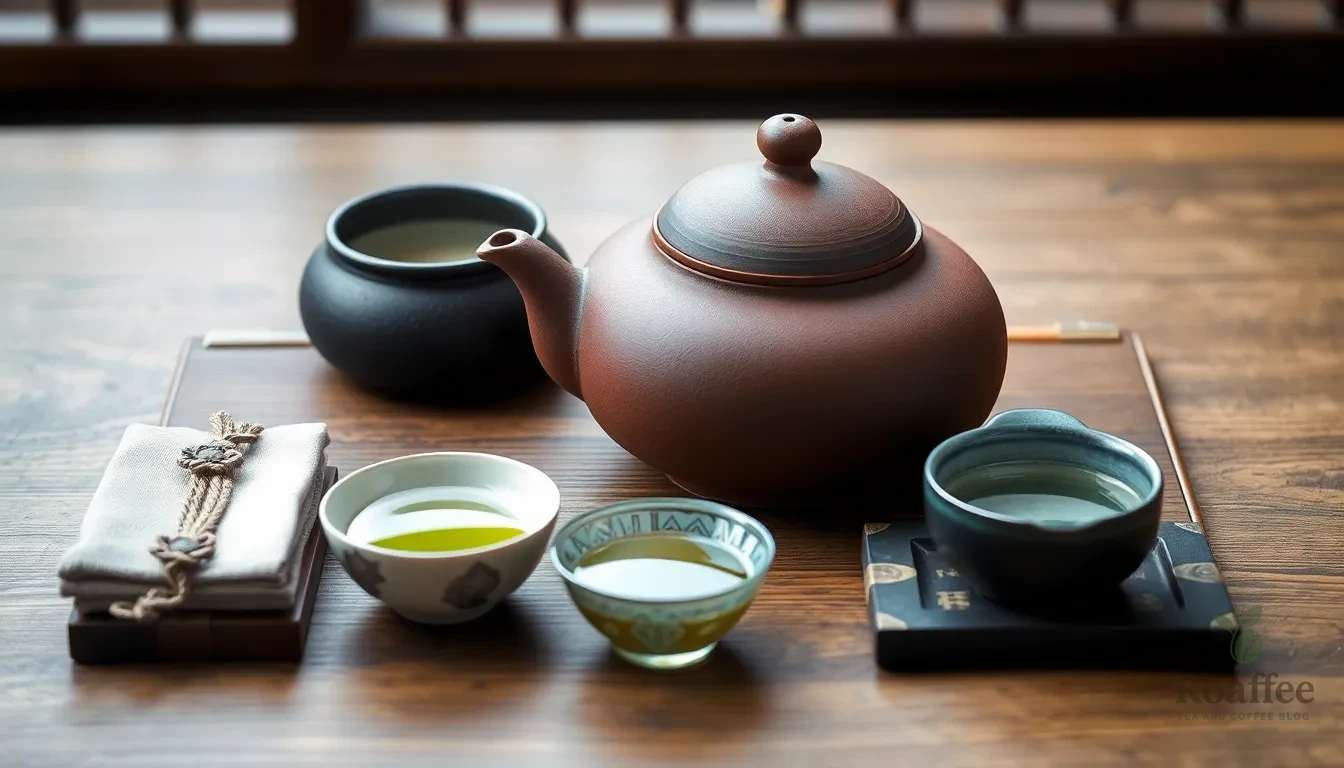
Having the right equipment transforms your green tea brewing experience from mediocre to exceptional. We recommend investing in exact tools that enhance flavor extraction while preventing the bitter compounds from overwhelming your cup.
Japanese Teapots for Optimal Brewing
A traditional side-handled ceramic teapot called a kyusu stands as the gold standard for brewing Japanese green teas. These teapots feature built-in ceramic strainers and are crafted from porous clay that improves flavor over time. The clay material helps regulate temperature and adds subtle mineral notes that complement green tea’s delicate profile.
For concentrated brewing experiences, specialized teapot styles like shiboridashi or houhin work exceptionally well with premium teas such as gyokuro. These vessels allow you to focus and intensify the tea’s natural flavors without adding unwanted bitterness.
Storage and Measuring Tools
Proper storage equipment protects your tea’s freshness and flavor integrity. We suggest using a chazutsu (tea leaf canister) to maintain optimal storage conditions for your loose leaf teas. This traditional canister prevents air exposure and moisture damage that can lead to stale, bitter flavors.
A chasaji (tea scoop) ensures consistent measurements for each brewing session. This specialized scoop helps you maintain the proper tea-to-water ratio, which directly impacts taste quality and strength.
Infusion Equipment
Quality infusers and strainers play crucial roles in preventing overbrew conditions that create bitter flavors. These tools allow proper leaf expansion while containing the tea leaves during steeping. Choose infusers with adequate space for leaves to unfurl completely, as cramped leaves often produce harsh, astringent flavors.
Mesh strainers with fine weaving catch even the smallest tea particles, ensuring your final cup remains smooth and pleasant. We recommend avoiding infusers with tiny holes that restrict leaf movement and water circulation.
Ingredients
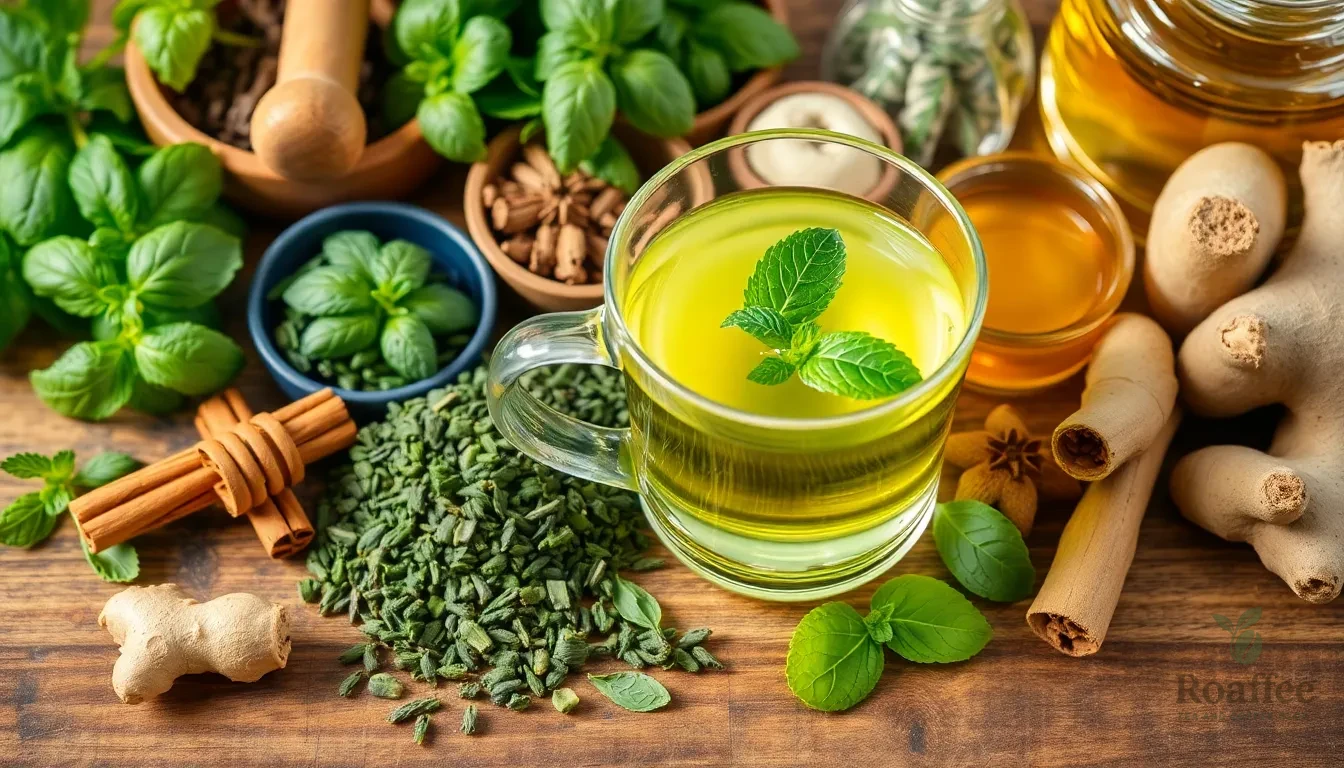
We’ve carefully selected ingredients that transform green tea from a bitter obligation into a delightful beverage. These components work together to balance flavor while preserving the health benefits that make green tea so valuable.
Base Ingredients
We recommend starting with high-quality green tea leaves such as Sencha or matcha, as freshness ensures better flavor development. The foundation of your perfect cup depends on selecting premium loose leaf varieties that offer complex flavor profiles without excessive bitterness.
Blending with other teas creates depth and reduces harsh notes. We suggest combining green tea with herbal blends like peppermint, rooibos, hibiscus, or fruit infusions to add complexity while mellowing the astringent qualities.
Fresh or dried herbs elevate the aromatic experience significantly. Our favorite additions include:
- Rosemary
- Mint
- Lemon basil
- Thyme
Ground spices add warmth and depth to your brew. We incorporate these flavorful options:
- Cinnamon
- Ginger
- Cardamom
- Nutmeg
- Cloves
- Star anise
Natural Sweeteners
Honey remains our traditional choice for subtle sweetness that maintains natural flavors. This golden sweetener may also soothe the throat while complementing green tea’s earthy notes.
Stevia leaf or extract provides sweetness without calories or refined sugar. We recommend using this sparingly due to its intense sweetness level that can easily overpower delicate tea flavors.
Maple syrup and agave nectar offer natural sweetening options that add flavor complexity. These alternatives help you avoid refined sugars while preserving green tea’s health benefits and taste nuances.
Jaggery serves as another natural, earthy sweetener option. This unrefined sugar provides mineral content while delivering a rich, molasses-like flavor that pairs beautifully with green tea.
Flavor Enhancers
Citrus zest or fresh slices brighten the overall flavor profile significantly. We add lemon, lime, orange, or green apple slices because their acidity balances bitterness while creating a refreshing taste experience.
Fresh or dried fruits and berries contribute sweet-tart notes that enhance complexity. Raspberries work particularly well for adding natural sweetness without overwhelming the tea’s base flavor.
A tiny pinch of salt enhances sweetness perception naturally. This surprising addition helps balance flavors while making the tea taste sweeter without adding actual sweeteners.
Flavor extracts, food-safe essential oils, or edible flower petals create aromatic complexity. We use these sparingly to add sophisticated notes that transform ordinary green tea into an exceptional beverage experience.
Water Temperature and Quality
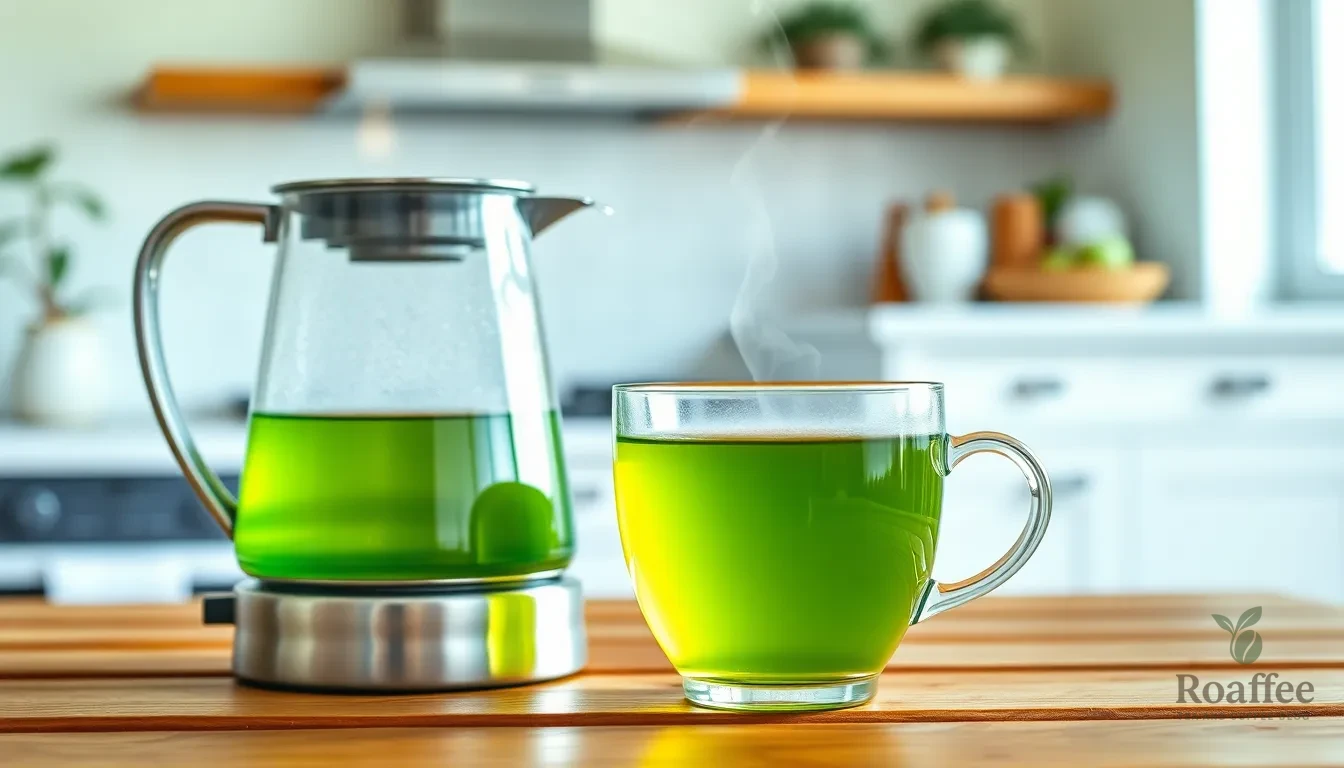
Getting the water temperature and quality right makes the difference between a bitter disappointment and a delicious cup of green tea. We’ll explore the precise temperature ranges and water quality standards that unlock green tea’s natural sweetness.
Optimal Water Temperature
Green tea requires water heated to 160°F to 180°F (70°C to 80°C) for optimal flavor extraction. Water hotter than this temperature burns the delicate tea leaves and creates excessive bitterness, while cooler water produces weak and flavorless tea.
Different green tea varieties require exact temperature adjustments for best results:
| Tea Type | Temperature Range | Fahrenheit |
|---|---|---|
| Sencha and Chinese greens | 70-80°C | 158-176°F |
| Gyokuro | 50-60°C | 122-140°F |
| Genmaicha, Bancha, Houjicha | Near boiling | 200-212°F |
We recommend boiling water and letting it sit for about 2-5 minutes before pouring if you don’t have a kettle with temperature controls. This simple technique helps achieve the ideal brewing temperature without specialized equipment.
Water Quality Tips
Fresh filtered water free from chlorine or strong mineral tastes creates the foundation for great green tea. Impurities in tap water can alter the flavor profile and mask the tea’s natural characteristics.
We avoid using hard or overly chlorinated tap water that can introduce metallic or chemical notes. Spring or purified water produces the cleanest taste and allows the tea’s subtle flavors to shine through.
The quality of your water directly impacts the final cup since tea is approximately 99% water. Using the best water available ensures that every brewing session delivers consistent and enjoyable results.
Steeping Instructions
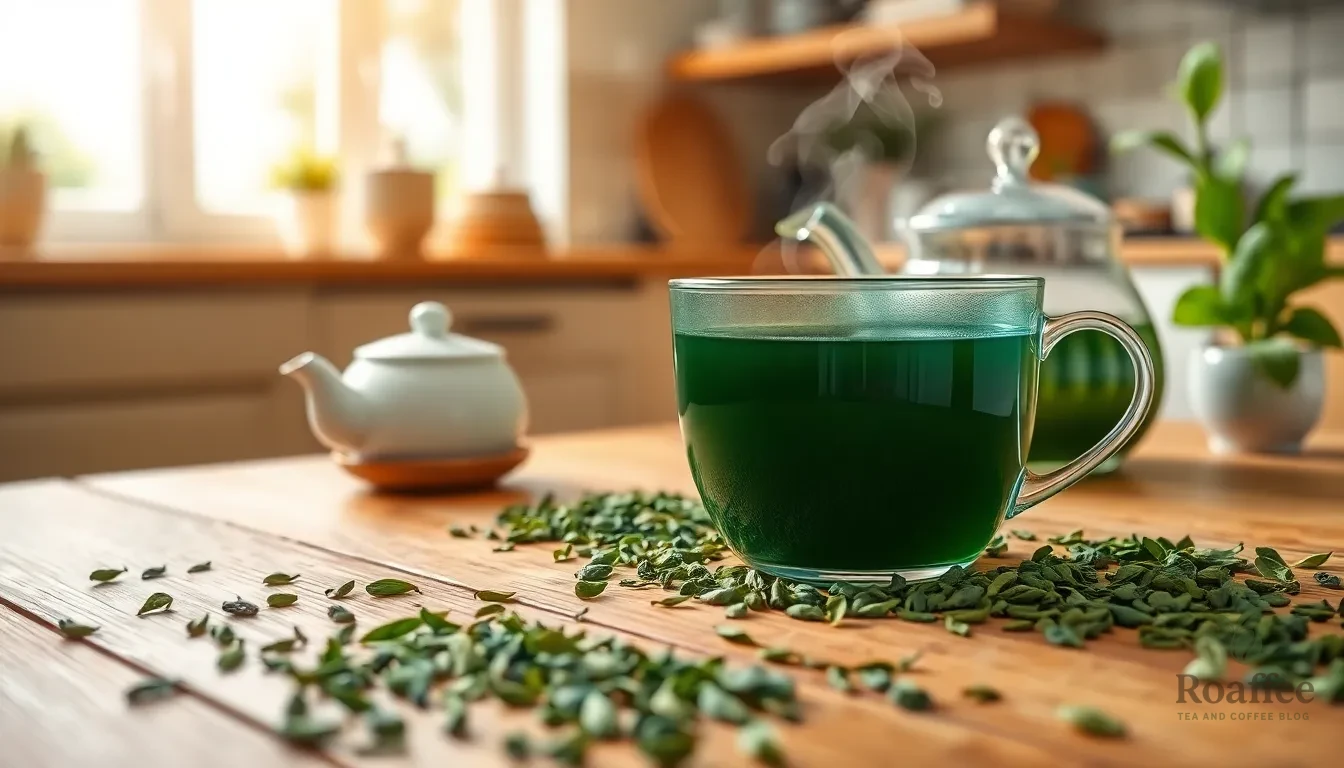
Mastering the art of steeping transforms green tea from a bitter disappointment into a delightful beverage. We’ll guide you through the essential timing and technique elements that make all the difference.
Timing Guidelines
Proper timing serves as the foundation for exceptional green tea flavor. We recommend steeping green tea for 2 to 3 minutes to achieve the perfect balance of taste and strength.
| Steeping Time | Flavor Profile | Best For |
|---|---|---|
| 1-2 minutes | Light, delicate | Beginners, sensitive palates |
| 2-3 minutes | Balanced, full-bodied | Most green tea varieties |
| 3+ minutes | Bitter, astringent | Avoid this range |
Start tasting your tea after about 1 to 2 minutes of steeping. Continue sampling every 30 seconds thereafter until you discover your preferred strength. This approach prevents oversteeping while helping you develop your personal taste preferences.
Avoid steeping longer than 3 minutes under any circumstances. Extended steeping extracts excessive tannins and creates that unpleasant bitter and astringent flavor we’re trying to eliminate. For lighter taste preferences, shorter steeping times between 1 to 2 minutes work particularly well with more delicate tea varieties.
Proper Steeping Technique
Temperature control remains crucial for exceptional green tea preparation. We heat water to approximately 80-85°C (176-185°F) rather than using boiling water, which damages delicate green tea leaves and releases bitter compounds.
Pour the heated water into your cup or teapot first, then add the tea leaves. This method provides better control over the infusion process and prevents shocking the delicate leaves with sudden temperature changes.
Allow ample space for the leaves to unfurl completely during steeping. Large infusers or strainers work best for this purpose, giving leaves room to expand and release their full flavor potential.
Pre-warm your cup or teapot by swirling hot water inside before adding tea. This technique protects delicate flavors during the brewing process and maintains consistent temperature throughout steeping.
Use approximately one teaspoon of tea leaves per 6 ounces of water as your starting point. Adjust the quantity based on your taste preferences and the exact tea variety you’re brewing. Reduce the amount of tea leaves if your brew tastes too strong or bitter rather than extending steeping time.
Remove tea leaves or tea bags promptly when your desired steep time is reached. This immediate removal prevents oversteeping and maintains the smooth, fresh flavor profile we’re aiming to achieve.
Flavoring Methods
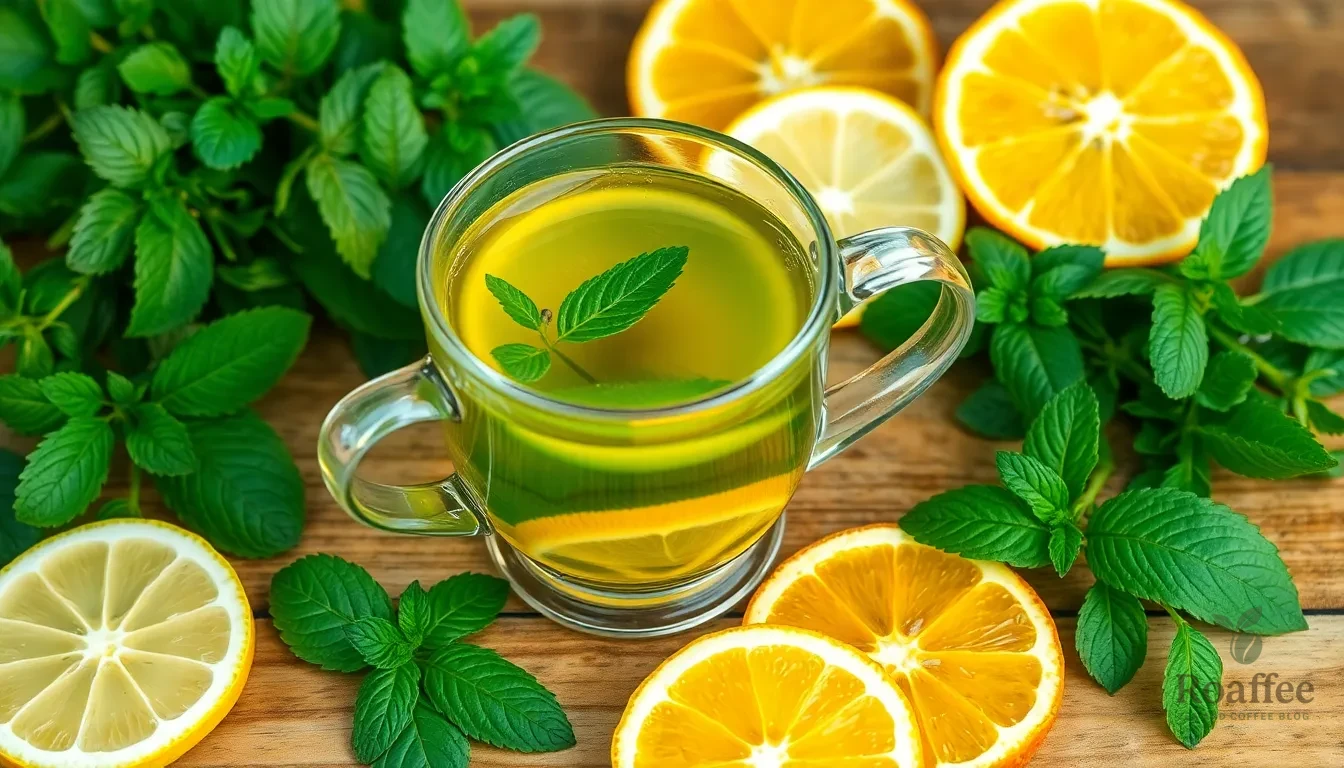
Now that we’ve mastered the fundamentals of brewing green tea, we can explore various flavoring methods to enhance its natural taste and create a more enjoyable drinking experience.
Adding Natural Sweeteners
We recommend starting with honey as our preferred natural sweetener because it adds mild floral sweetness while providing health benefits like antioxidants and soothing effects. Add one teaspoon to your cup after brewing for optimal flavor integration.
Stevia offers an excellent calorie-free alternative that delivers intense sweetness without affecting blood sugar levels. This natural leaf-based sweetener proves 200-300 times sweeter than regular sugar, so we suggest using it sparingly to avoid overpowering the delicate green tea flavors.
Agave nectar and maple syrup provide additional natural sweetening options with mild flavor profiles that complement green tea beautifully. Both alternatives help us avoid refined sugar while maintaining the tea’s health benefits.
Traditional rock sugar serves as another gentle sweetening method often used in authentic tea preparation ceremonies. This crystalline sweetener dissolves slowly and provides subtle sweetness that doesn’t compete with the tea’s natural character.
Citrus Enhancements
Fresh citrus transforms green tea by adding bright, refreshing tanginess that balances any remaining bitterness. We can use slices or juice from lemons, limes, or oranges to create vibrant flavor combinations that awaken the palate.
Lemon works particularly well because it enhances vitamin C content and helps our bodies absorb green tea antioxidants more effectively. The natural acidity brightens the overall taste profile while providing additional health benefits.
Orange slices contribute natural sweetness along with citrus brightness, creating a more complex flavor experience. Lime offers a sharper, more intense citrus note that pairs especially well with mint-infused green tea.
We can experiment with citrus zest for more concentrated flavor impact without adding extra liquid to our tea. Fresh zest releases essential oils that provide aromatic enhancement along with taste improvement.
Herbal Additions
Fresh herbs create aromatic complexity that transforms ordinary green tea into a sophisticated beverage experience. We recommend starting with mint, basil, or rosemary to add fresh, natural flavors that complement rather than overpower the tea.
Mint provides cooling properties that make green tea more refreshing, especially during warmer weather. Fresh mint leaves can be muddled gently in the cup before adding the brewed tea, or we can steep them together for integrated flavor.
Basil offers an unexpected twist with its sweet, slightly spicy notes that pair beautifully with green tea’s earthy undertones. We suggest using fresh basil leaves rather than dried for the best flavor impact.
Rosemary brings piney, aromatic qualities that create a more complex flavor profile. This herb works particularly well when we want to create a more sophisticated, adult-oriented green tea experience.
Spice Combinations
Warming spices enrich green tea with depth and complexity while providing additional health benefits. We recommend experimenting with ginger, cinnamon, and other aromatic spices to create personalized flavor profiles.
Fresh ginger adds warmth and can help relieve cold symptoms while providing natural anti-inflammatory benefits. We can slice fresh ginger root and steep it with the tea leaves, or add ground ginger powder for convenience.
Cinnamon offers natural spiciness that uplifts mood while providing blood sugar regulation benefits. We suggest using Ceylon cinnamon for its milder, sweeter flavor compared to the more common cassia variety.
Cardamom pods create exotic, floral notes that transport green tea into chai-like territory. We can lightly crush the pods before steeping to release their aromatic oils more effectively.
These spice combinations work best when we layer them thoughtfully, starting with smaller amounts and adjusting to taste preferences over multiple brewing sessions.
Temperature Serving Options
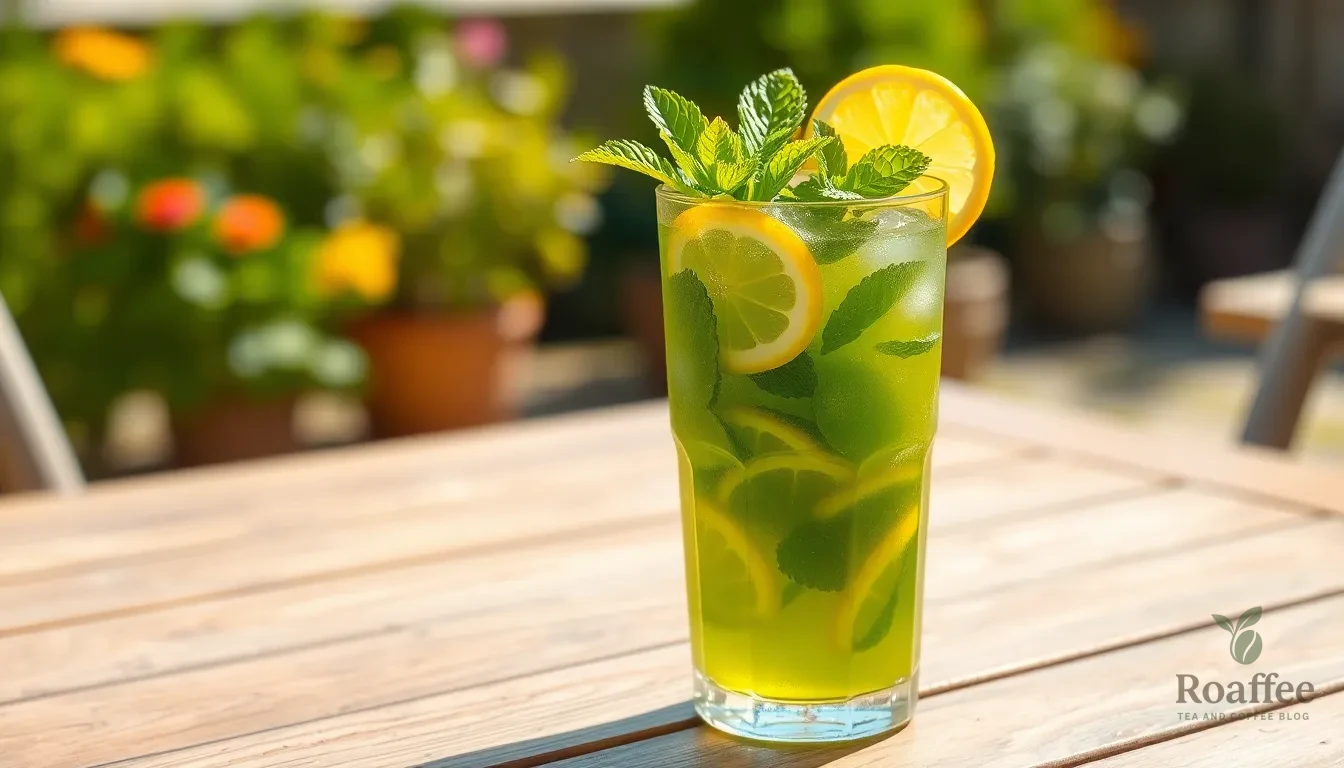
We can transform green tea into a delightful beverage by choosing the right serving temperature and preparation method. Both hot and iced variations offer unique opportunities to showcase green tea’s natural flavors while avoiding the bitterness that often deters tea drinkers.
Hot Green Tea Preparations
Hot green tea requires precise temperature control to unlock its delicate flavors without creating harsh bitterness. We recommend heating water to 175–180°F (80–82°C) for optimal extraction, as this temperature range allows the tea leaves to release their earthy and slightly sweet notes without burning.
When preparing hot green tea, we start by heating water just until it reaches the ideal temperature range. If we only have boiling water available, we let it cool for 2-3 minutes before pouring over the tea leaves or tea bag. We use approximately 3 grams of tea per cup to achieve the perfect strength balance.
The steeping process demands careful timing to prevent over-extraction. We steep the tea for 2-3 minutes, then immediately remove the leaves to stop the brewing process. This timing prevents the release of excessive tannins that create unwanted bitterness.
After brewing, we can enhance the flavor profile by adding natural sweeteners, fresh lemon slices, or aromatic herbs like mint. These additions complement the tea’s natural characteristics while creating a more personalized drinking experience.
Iced Green Tea Variations
Iced green tea offers refreshing alternatives perfect for warm weather while maintaining the tea’s beneficial properties. We brew iced green tea at a slightly higher temperature of around 190°F (88°C) but reduce the steeping time to 3-4 minutes to preserve the tea’s delicate flavor balance.
The preparation process begins with brewing the tea hot using the higher temperature setting. We allow the brewed tea to cool for approximately 10 minutes after steeping to prevent the ice from melting too quickly when served.
Once cooled, we pour the tea over ice and serve immediately for the best taste experience. The quick cooling process helps lock in the tea’s fresh flavors while creating a refreshing beverage.
We can customize iced green tea with various flavor enhancers to create unique variations. Fresh mint leaves add cooling aromatics, while lemon slices provide citrusy brightness. Berries introduce natural sweetness and visual appeal, and mixing with lemonade creates a more complex flavor profile perfect for summer entertaining.
| Aspect | Hot Green Tea | Iced Green Tea |
|---|---|---|
| Water Temperature | 175–180°F (80–82°C) | ~190°F (88°C) |
| Steeping Time | 2-3 minutes | 3-4 minutes |
| Serving | Hot cup | Over ice, chilled |
| Flavor Enhancers | Lemon, mint, sweetener | Mint, lemon, berries, lemonade |
Storage and Make-Ahead Tips
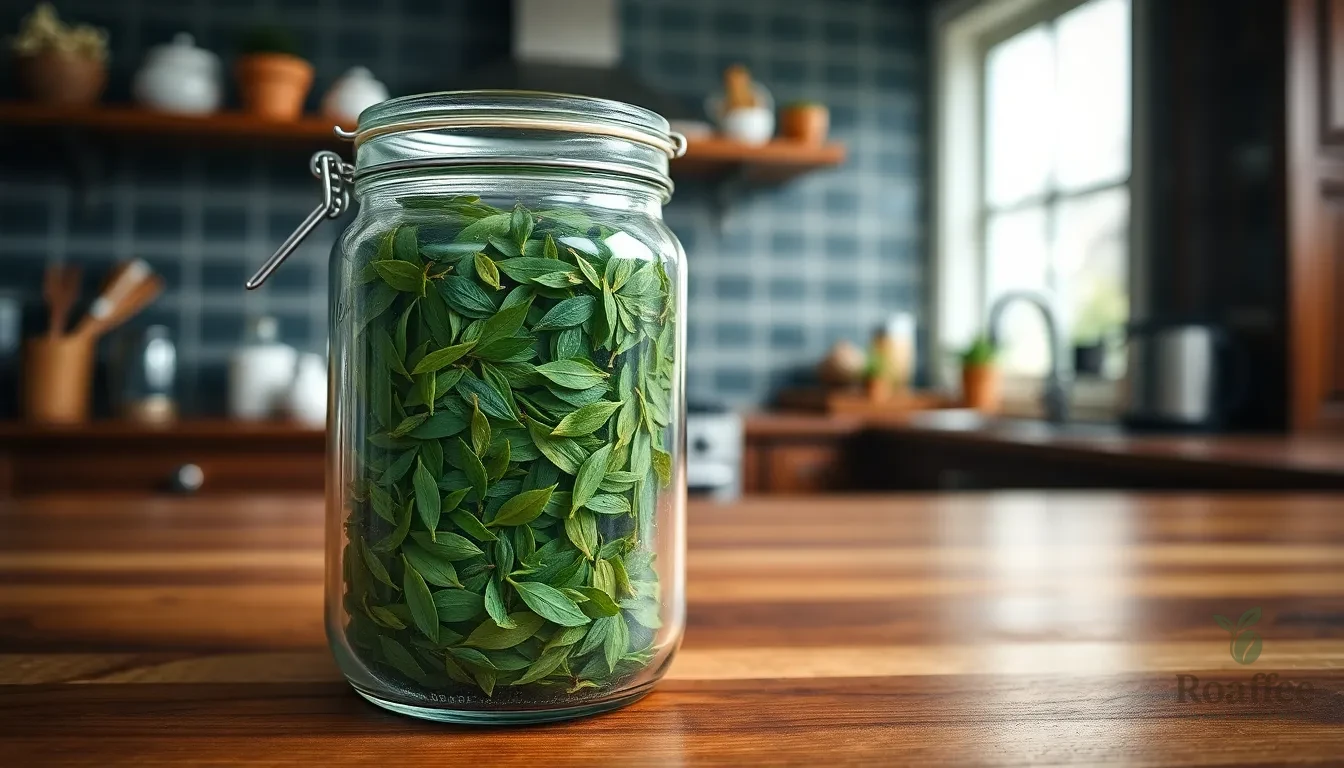
Proper storage techniques and make-ahead preparation methods ensure we can enjoy consistently flavorful green tea while extending its shelf life. These strategies help preserve the delicate compounds that make green tea both healthy and delicious.
Storing Loose Leaf Tea
Opaque, airtight containers serve as our first line of defense against the four main enemies of tea quality: light, air, heat, and moisture. We recommend investing in containers specifically designed for tea storage, such as a traditional Japanese chazutsu or modern airtight canisters with tight-fitting lids.
Location matters significantly when storing our precious loose leaf tea. We should keep containers in a cool, dark place away from direct sunlight, heat sources, and areas with high humidity like near stoves or dishwashers. Strong odors from spices, coffee, or cleaning products can also penetrate tea leaves, so we maintain distance from these potential contaminants.
Labeling containers with purchase or expiry dates helps us track freshness and rotate our tea supply effectively. Fresh green tea typically maintains optimal flavor for 12-24 months when stored properly, though we notice the best taste within the first 6-12 months.
| Storage Factor | Recommendation | Why It Matters |
|---|---|---|
| Container Type | Opaque, airtight | Blocks light and air exposure |
| Location | Cool, dark place | Prevents heat and light degradation |
| Temperature | Room temperature or cooler | Slows oxidation process |
| Humidity | Low humidity environment | Prevents mold and staleness |
| Labeling | Date of purchase/expiry | Tracks freshness timeline |
For large quantities of premium tea, refrigeration becomes an option, though we must watch carefully for condensation when removing containers from cold storage. We recommend letting refrigerated tea reach room temperature before opening to prevent moisture buildup.
Preparing Tea Concentrates
Brewing stronger than usual creates versatile tea concentrates that we can dilute with water or milk when serving. This method allows us to control flavor intensity while saving time during busy mornings or when entertaining guests.
We brew concentrates using double the normal amount of tea leaves – approximately 2 teaspoons per 6 ounces of water instead of the standard 1 teaspoon. Water temperature remains consistent at 160-180°F, but we extend steeping time to 4-5 minutes to extract maximum flavor without excessive bitterness.
Concentrates can be stored refrigerated in airtight containers for up to one week, maintaining their flavor profile when properly sealed. Glass containers work best for storage, as they don’t absorb flavors and clean easily between batches.
We can enjoy these concentrates both hot and cold by adjusting dilution ratios to personal preference. For hot tea, we mix equal parts concentrate and hot water, while iced preparations benefit from a 1:2 ratio of concentrate to cold water over ice. This flexibility allows us to customize strength and temperature without compromising the carefully balanced flavors we’ve worked to achieve.
Adding sweeteners or flavor enhancers to concentrates before storage creates ready-to-serve beverages that only require dilution. We find this particularly useful for flavored green tea lattes or refreshing summer iced teas that can be prepared quickly when guests arrive.
Troubleshooting Common Issues
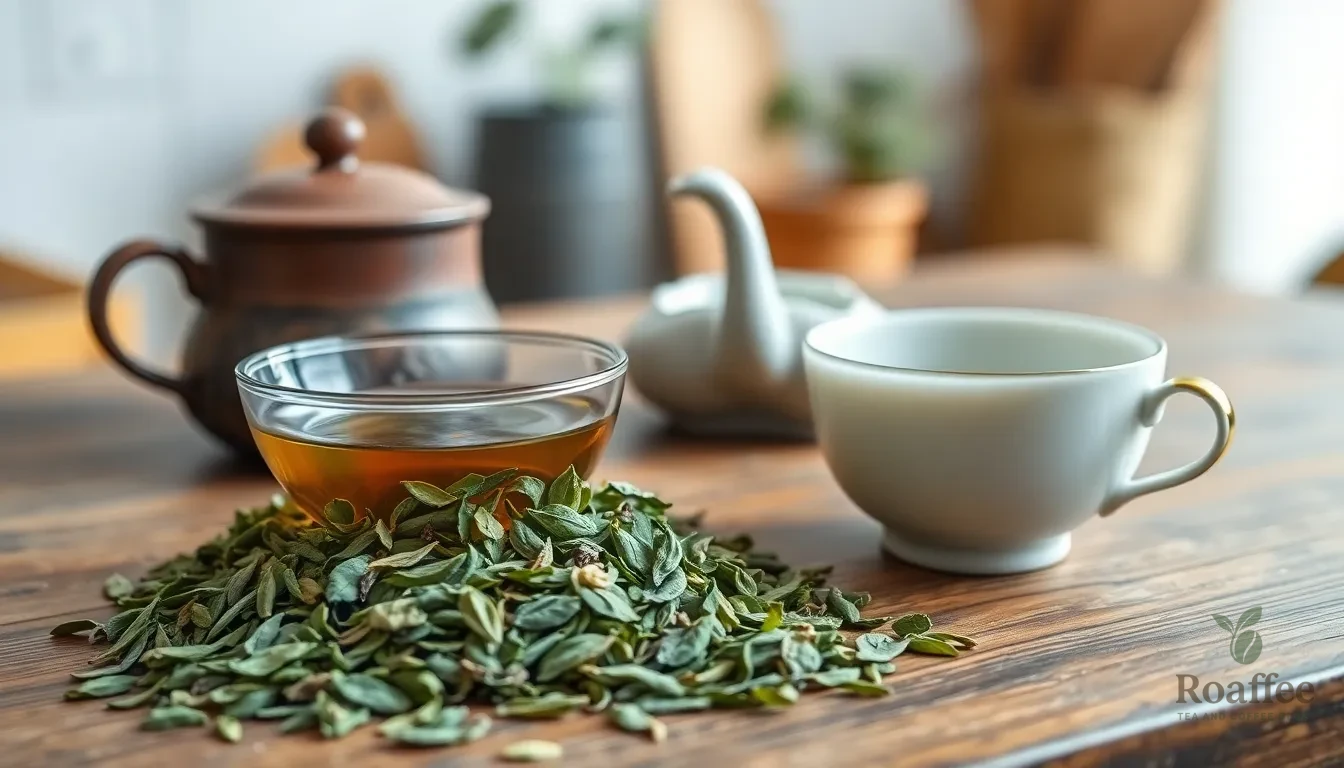
Even with proper technique, green tea can sometimes present challenges that affect our enjoyment. We can address these common issues with targeted answers to ensure every cup delivers the smooth, flavorful experience we’re seeking.
Fixing Bitter Tea
Bitter green tea results from several brewing mistakes that we can easily correct. Water temperature serves as the primary culprit when we use boiling water at 212°F (100°C), which burns the delicate leaves and releases harsh compounds. We should cool our water to 175-180°F (80-82°C) and let boiling water rest for 2-3 minutes before steeping.
Oversteeping creates another common source of bitterness that we can prevent by limiting our steeping time to 1-2 minutes maximum. We recommend starting with just 1 minute, then tasting every 30 seconds to find our preferred strength without extracting bitter tannins. This shorter steeping preserves the tea’s natural sweetness and umami flavors that make green tea enjoyable.
Low-quality tea leaves contribute significantly to bitter flavors, so we should invest in whole leaf teas rather than tea bags containing dust and broken pieces. Higher-grade loose leaf green teas provide smoother, more complex flavors with fewer bitter notes. We can also choose naturally sweeter cultivars like Saemidori or Asatsuyu instead of more bitter varieties like Yabukita.
Shaded teas offer another solution since they retain more theanine, which enhances sweetness while reducing bitterness. These teas grow under special nets that modify their chemical composition for a more pleasant drinking experience.
Adjusting Strength
Strong green tea often overwhelms our palate and masks the subtle flavors we want to enjoy. We can reduce the strength by using fewer tea leaves rather than shortening steeping time, which allows proper flavor extraction without creating an overly concentrated brew. Start with about half a teaspoon of leaves per 6 ounces of water and adjust based on our taste preferences.
Diluting already-brewed strong tea with hot water provides an immediate fix when we’ve used too many leaves. This method maintains the proper temperature while bringing the strength to our desired level. We can also prepare a lighter second steeping from the same leaves, which often produces a gentler flavor profile.
| Issue | Cause | Solution |
|---|---|---|
| Bitter taste | Boiling water; too long steeping; low-quality tea leaves | Use cooler water (175-180°F); steep 1-2 minutes; buy quality leaves |
| Too strong | Too many leaves | Reduce leaf quantity |
| Sour flavor | Possibly lemon or improper brewing | Avoid lemon or adjust steeping |
Temperature control becomes crucial when adjusting strength since cooler water extracts flavors more gently. We can experiment with slightly lower temperatures around 160-170°F (71-77°C) for delicate teas that tend to become too strong with standard brewing methods.
Recipe Variations
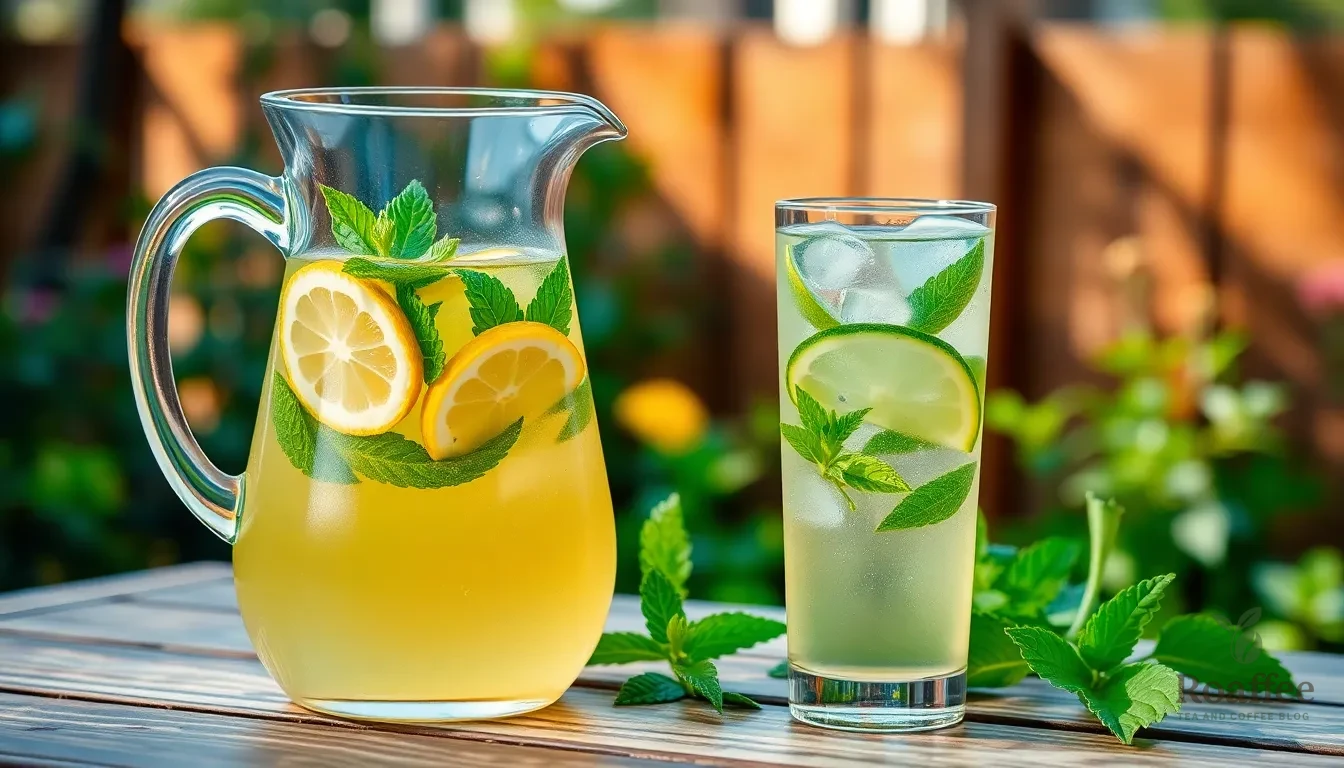
We’ve crafted three delicious variations that transform green tea from a bitter obligation into a delightful beverage. Each recipe builds upon the fundamental brewing techniques to create unique flavor profiles that appeal to different tastes.
Honey Ginger Green Tea
We begin by bringing 4 cups of water to a boil with 1 two-inch piece of peeled, chopped fresh ginger and 1 stalk of lemongrass that has been trimmed and cut. Once the water reaches a rolling boil, we turn off the heat completely and add a green tea bag to the mixture.
The tea steeps for 3 to 5 minutes, allowing the flavors to meld without becoming bitter. We remove the tea bag and stir in ¼ cup honey while the mixture remains warm, ensuring complete dissolution.
After covering the mixture, we let it sit for 30 minutes to allow the flavors to develop fully. We strain the tea into a pitcher and chill for 1 hour before serving over ice. This refreshing beverage pairs exceptionally well with spicy dishes and offers a mild, lemony, and sweet flavor profile.
Mint Green Tea
We start by boiling 4 cups of water with 1 inch of fresh ginger to create an aromatic base. Once the water reaches a boil, we add 4 teaspoons of green tea leaves or bags along with ¼ cup fresh mint leaves to the hot water.
The mixture steeps for approximately 10 minutes, allowing the mint and ginger to infuse their flavors throughout the tea. We strain the tea to remove all solid particles, then stir in 2 tablespoons honey and 2 tablespoons fresh lemon juice while the tea remains warm.
This energizing beverage can be served hot for a warming drink or poured over ice for a refreshing summer treat. High-quality green teas like Sencha or Dragonwell enhance both the flavor and health benefits of this variation.
Jasmine Green Tea Blend
We brew 4 teaspoons of jasmine green tea with 4 cups of water heated to 160 to 180°F, steeping for only 2 to 3 minutes to prevent bitterness from developing. The precise temperature control ensures that the delicate jasmine flowers release their floral notes without overwhelming the green tea base.
After removing the tea leaves, we stir in 2 to 3 tablespoons honey while the tea remains warm for optimal mixing. We add 8 to 10 fresh mint leaves and allow them to steep as the tea cools naturally.
Once the tea reaches room temperature, we refrigerate until thoroughly chilled and serve over ice with mint or lemon slices as garnish. Creative variations include infusing herbs like basil or rosemary, substituting agave nectar for honey, or adding sparkling water for a fizzy twist.
| Temperature | Steeping Time | Water Amount | Tea Amount |
|---|---|---|---|
| 160-180°F | 2-3 minutes | 4 cups | 4 teaspoons |
| 175-180°F | 3-5 minutes | 4 cups | 1 tea bag |
| 190°F | 10 minutes | 4 cups | 4 teaspoons |
Conclusion
We’ve shared the essential techniques and insider tips that’ll transform your green tea from bitter disappointment into a delightful daily ritual. By mastering water temperature control steeping times and selecting quality ingredients you now have the tools to create consistently flavorful cups that you’ll actually look forward to drinking.
The key lies in understanding that green tea’s natural complexity can be enhanced rather than masked. Whether you prefer it hot with honey and ginger or iced with fresh mint the possibilities are endless once you’ve got the fundamentals down.
Remember that finding your perfect cup is a journey of experimentation. Don’t be afraid to adjust ratios try new flavor combinations and explore different varieties until you discover what works best for your taste preferences. Your ideal green tea experience is waiting to be discovered.
Frequently Asked Questions
Why does green tea taste bitter?
Green tea tastes bitter due to excessive extraction of tannins and catechins from the leaves. Common causes include using boiling water (over 180°F), oversteeping beyond 3 minutes, using low-quality tea leaves, or improper storage. Individual sensitivity to bitter compounds also varies, affecting personal taste preferences.
What’s the ideal water temperature for brewing green tea?
The optimal water temperature for green tea is between 160°F to 180°F (70°C to 80°C). Water that’s too hot burns the delicate leaves and creates bitterness, while cooler water results in weak tea. Different green tea varieties may require slight temperature adjustments within this range.
How long should I steep green tea?
Steep green tea for 2-3 minutes for balanced flavor. Steeping longer than 3 minutes typically results in excessive bitterness. Use about one teaspoon of tea leaves per 6 ounces of water, and adjust timing based on your taste preferences and the specific tea variety.
What are the best green tea varieties for beginners?
Beginners should start with milder varieties like Sencha, Dragonwell, and Genmaicha. These offer smoother, less bitter flavors compared to stronger varieties. High-quality loose leaf teas are recommended over tea bags, as they provide better flavor complexity and less bitterness.
How can I make green tea taste better?
Add natural sweeteners like honey or stevia, citrus fruits (lemon, lime, orange), fresh herbs (mint, basil), or warming spices (ginger, cinnamon). These enhancements balance bitterness while preserving health benefits. Start with small amounts and adjust to your taste preferences.
What’s the difference between hot and iced green tea preparation?
Hot green tea should be brewed at 175-180°F for 2-3 minutes. Iced green tea requires slightly hotter water (190°F) and longer steeping (3-4 minutes) to maintain flavor when diluted with ice. Both can be customized with flavor enhancers like lemon or mint.
How should I store green tea to maintain freshness?
Store green tea in opaque, airtight containers away from light, air, heat, and moisture. Keep in a cool, dark place away from strong odors. Label containers to track freshness. For premium teas in large quantities, refrigeration is acceptable with proper moisture protection.
What equipment do I need for brewing green tea?
Essential tools include a quality teapot (kyusu for traditional brewing), proper infusers or strainers, a tea scoop for consistent measurements, and storage containers. A thermometer helps maintain proper water temperature. Quality equipment prevents overbrewing and ensures smooth, flavorful tea.
Can I prepare green tea in advance?
Yes, you can brew tea concentrates that can be diluted when serving. This allows for customizable flavor intensity and convenience. Store prepared tea in the refrigerator and consume within 2-3 days for best quality and flavor.
How do I fix overly bitter green tea?
Reduce water temperature to 160-175°F, shorten steeping time to 2 minutes, use higher-quality loose leaf tea, and ensure proper storage. You can also add natural sweeteners or citrus to balance existing bitter tea. Consider diluting overly strong tea with fresh hot water.

